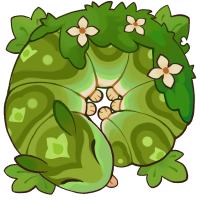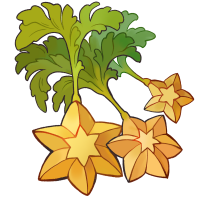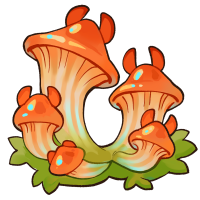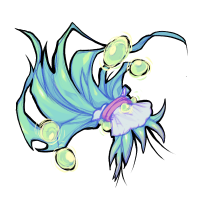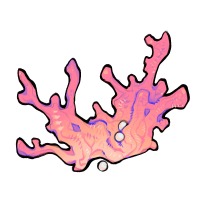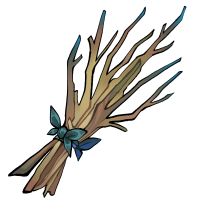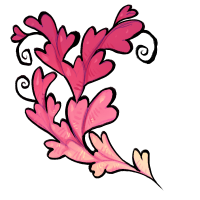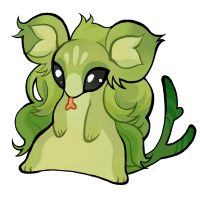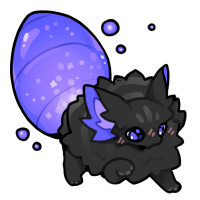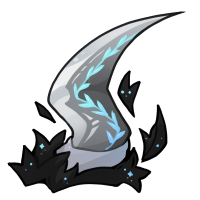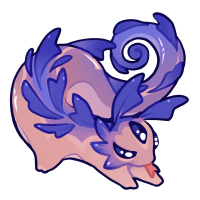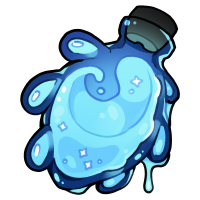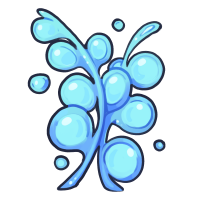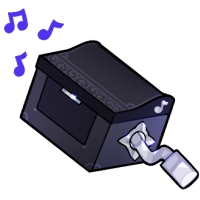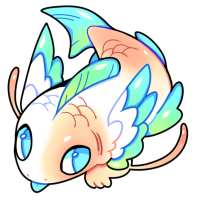Items
Rare Unvoiding Ticket
Can be used to Unvoid any Terralien with a Rare Subtyping (Reptile or Marine). Cannot be used on any other rarity.
Uses: Used to Unvoid a Rare Terralien.
Availability
Source:
Purchased from the Unvoiding Shop
Purchaseable At:
Uncommon Unvoiding Ticket
Can be used to Unvoid any Terralien with an Uncommon Subtyping (Beast or Amphibian). Cannot be used on any other rarity.
Uses: Used to Unvoid an Uncommon Terralien.
Availability
Source:
Purchased from the Unvoiding Shop
Purchaseable At:
Common Unvoiding Ticket
Can be used to Unvoid any Terralien with a Common Subtyping (Bug or Sprout). Cannot be used on any other rarity.
Uses: Used to Unvoid a Common Terralien.
Availability
Source:
Purchased from the Unvoiding Shop
Purchaseable At:
Caterblossom
The caterblossom is a rodent-sized insect that survives through a form of symbiosis. They spend their first months of existence being entirely dormant, allowing for plants to entangle into their body. The lifeforms then merge together, and through photosynthesis the caterblossom gains its energy. Due to relying on the energy of the plants directly to move, they tend to be incredibly slow paced. They enjoy being watered, as the more plant growth present on a caterblossom, the more energy they produce. These creatures have become a somewhat popular pet due to their low-maintenance nature.
Availability
Source:
Grasslands Foraging
Staradish
These crisp vegetables are known for their strong flavor, possessing a slight spice that acts as a grand accent to any dish. Almost in spite of their peculiar star-like shape, they are most commonly ground up into a fine paste used to enhance the taste of meats. They can also be sliced up to feed to one’s critter for a simpler yet still delectable meal. The leaves of the staradish can often be seen protruding from the fields of the grassland. Though as the annual harvest creeps around, their population tends to dwindle as Terras prepare for the winter.
Availability
Source:
Grasslands Foraging
Pangosprout
The rustling of underbrush is a sound synonymous with these scaly little beasties, for they spend most of their days darting from plant to plant as they hunt for small insects or rodents to consume. When hunting, they utilize the stinger at the end of their tail to pin the prey down and insert venom into their victim, causing paralysis. They tend to be slow eaters, and can make a single meal last several days. When sleeping, they coil into a ball-like shape. Their outer scales possess a vibrant green hue, allowing them to camouflage as a part of the very plants they reside within to protect from potential hunters.
Availability
Source:
Grasslands Foraging
Buncap Bolette
These petite fungi are often found sprouting near the bases of tree trunks. Their mycelium intertwines with the roots of said tree, or plant in some cases, and feeds off of the nutrients provided. They spread through the small nubs that form atop their cap, with a strong gust of wind able to shake these sprouts from the mushroom to blow them to a new location. The infantile fungi will then latch on to a new host and grow. While the infant buncap bolettes are technically edible with no known side effects, their taste has been reported to be extremely bitter with a stringy texture.
Availability
Source:
Grasslands Foraging
Viridian Kelp
These tall swaying strands of kelp remain commonplace when swimming beneath the pletium sea. Providing a habitat and hiding spot for the creatures of the deep, they are a crucial part of the ecosystem. Though they can also be utilized as a food source, in recent times blades of kelp have found themselves on land as Terras find new ways to feed their critters. What is somewhat peculiar about viridian kelp in particular, are the chartreuse green bubbles that form around them, a direct result of their photosynthesis. These bubbles are produced directly from the plant's roots, that then travel up to the surface as they release more air into the sky. However, they can be utilized by semi-aquatic Terras in order to collect air for their sensors in a pinch.
Availability
Source:
Pletium Lakes Foraging
Sunset Coral
As you swim past the iridescent layer of the pletium sea, these merry plants provide warmth in darker blues of the liquid. This warm coral tends to sprout across vast stretches of the sea floor, often growing off of large rocks. It has a symbiotic relationship with a particular algae that decorates the surface of the coral, giving it its sunset hues. This relative of the amorous algae also assists the coral in fighting off harmful bacteria, by forming coats around it that manifest as small pearls often pooling up in the middle of the coral. These pearls have become popular for making accessories across Terrah, with a small market for perfectly shaped pieces having grown over time.
Availability
Source:
Pletium Lakes Foraging
Bundled Brush
Since that fateful day, plant life has failed to thrive in these parts anymore. Twigs and remnants of trees now protrude lifelessly across the tundra. The only thing they’re good for now is a fire pit, which if you're planning on staying out in the cold much longer would be a smart thing to put together. Even the branches themselves feel devoid of anything but frost of the tundra, being icey to the touch. But at the end of the day, they’ll burn fine.
Availability
Source:
Tundra Foraging
Amorous Algae
This algae possesses a peculiar shape, each leaf folded into a delicate heart while its stem is coiled in spirals. They are primarily found in areas closer to the shores of Terrah in order to reach adequate sunlight for photosynthesis. Though due to their poor anchoring abilities, they can often be found washed up on the beaches. While their bitter taste contrasts their vibrant colors, Terras have still found a handful of uses for this plant. For example, rich warm dyes can be achieved from the algae as well as decoration for Terra’s tanks. Their twisted stems can also be spun into a fine thread, which in the earlier days of populating the planet helped to craft clothing to keep warm during the winters.
Name Credit to @jadeybabey on Discord!
Availability
Source:
Pletium Lakes Foraging
Chivemunk
The infamous sight of their tail waving from between the crops is a farmer's worst nightmare. These speedy pests often will dig themselves beneath the ground, leaving their tail out as camouflage while they consume and collect any produce they can find. When gathering, they can inflate their cheeks to store food to return to their burrow with. During colder seasons, they will enter a state of torpor to conserve energy. Thanks to this, wherever there is a farm, it’s likely that a chivemunk burrow is closeby. Chivemunk domestication has been attempted, however other than providing company they don’t offer many benefits.
Availability
Source:
Grasslands Foraging
Goobug
When strolling late at night in the lush forest, the delicate glow of a goobug is often present thanks to their nocturnal nature. These bugs live in large colonies, often using large leaves to cover the nest of their burrow. It is believed they use the burrow to prevent predators from seeing the nest's glow during the night. Their tails are soft yet slightly sticky, a texture achieved by small pores across it which secrete the liquid from their inner tail to its surface. They then use their sticky tails to pollinate, dipping them into the center of plants to collect and transfer pollen. Their glow is used to locate other bugs late at night, and to prevent them from visiting the same plant more than once. To feed, the liquid produced on the surface of their tail acts akin to stomach acid and directly digests into their body when they sleep.
Availability
Source:
Lush Forest Foraging
Forgotten Claw
This ferocious fallen talon possesses intricate patterns which seem to be a part of the claw; it appears to be what was left of a nervous system. Further inspection suggests this object was directly removed from the skin rather than lost on accident due to the fur surrounding its base. The fur itself is slightly shimmery, softly coated in iridescent dust. Perhaps a few spores from a globerry latched onto the unguis? Regardless, whatever beast this came from was clearly colossal, for the item fits comfortably in the size of an adult Terra’s hand.
Availability
Source:
Lush Forest Foraging
Irradiabranch
When flipping through stones at the brim of the lakes of the lush forest, you might spy one of these amphibious beings staring back at you. Their slippery bodies are incredibly nimble, as they often slide through the mud, or burrow beneath it to rest. In order to hunt for prey, they will dig beneath the banks of a lake, leaving their tail out to entice small aquatic animals. When they bite onto the tail, the small fins will sting the predator with a noxious chemical. Being that they are able to fully regenerate any part of their body, the bite from their prey is no issue for the irradiabranch. Once the animal releases their tail, they will then proceed to stalk whatever fell for its trap and consume it once it succumbs to their sting.
Availability
Source:
Lush Forest Foraging
Ferroflask
This vial contains the bioluminescent sap from trees commonly found in the lush forest. The sap is believed to have healing properties, as well as a high iron content. Though outside of consumption, the tree sap can also be used as a makeshift lantern thanks to its vibrant glow. If exposed to air for a prolonged period, the sap will solidify and lose its bioluminescence, allowing it to be used as a sealant in a lot of the homes found within the lush forest. Whoever left this flask behind is clearly missing out!
Availability
Source:
Lush Forest Foraging
Globerries
A crunchy yet juicy texture makes the globerry a very popular fruit across Terrah. They’ve been harvested since the beginning of Terraliens’ presence on the planet, and throughout the lush forest are a handful of small farms that focus solely on achieving the necessary environments to produce these berries. They require darkness and moisture to grow, and in the wild often sit at the base of the trees to maintain consistent shade. Once ripe they will begin to glow vibrantly to entice nocturnal animals to consume them, as within the center of each berry contains two of seeds which can be spread when an animal defecates.
Availability
Source:
Lush Forest Foraging
Melodical Muse
Foraged from the Nowhere.
To use: Select the item and press "open box".
Potential rewards include:
- 5x-10x Pupa Seeds
- The Music Note item.
- Any Grubsprout item.
- Any Pupa Seed item, excluding Glow Vial, Amber Crypt, Field Kit & Psych-Shroom.
Music Note
Foraged from the Nowhere. Awards 1-5 pupa seeds.
To use: Select the item and press "open box".
Soarfish
Category: Forageables
Resale Value: 25 ![]()
Soarfish are known as one of the most common types of flying fish found on planet Terrah. These fish are often spotted soaring across the skies above the Pletium Lakes, though they dive into the iridescent bodies of water from time to time. Notably, this behavior is more common in spring due to their spawning and hatching. On an annual basis, the soarfishing festival is hosted on the coastline of the Pletium Lakes where many Terraliens will stand in the water with nets in hand as they try to catch the largest Soarfish!



